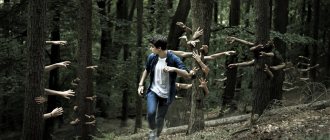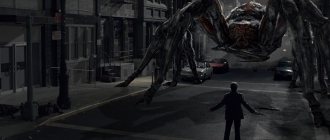Pediophobia is the fear of mannequins, robots, any dolls - from luxurious porcelain beauties to ordinary rubber baby dolls. Panic fear occurs when looking at any imitation of a person or other living beings.
There is no consensus among doctors regarding the causes of the disease. The famous psychologist Sigmund Freud associates the fear of dolls with severe childhood shocks. The immature psyche of a child perceives the doll world as reality.
Impressionable children are firmly convinced that dolls wake up when everyone is asleep or no one is looking at them. The fear of living dolls takes root in the mind and becomes an obsessive fear.
The inscription on the sign “ATTENTION, opening is strictly prohibited.” The famous Annabelle doll, which, according to the owners, moved things.
Pediophobia in adults manifests itself in the form of panic attacks . If a sick person has been exposed to this condition more than once and he knows the reason, he tries in every possible way to avoid the objects of the phobia, in this case dolls. A psychological protective barrier is triggered.
If the object of fear cannot be avoided, acute neurosis manifests itself. When a person cannot control his reactions to the sight of dolls, we can talk about the development of a disease, which must be diagnosed and treated by a specialist.
Why are people afraid of dolls
The cause of pediophobia must be sought in early childhood. The child endows the toy with human qualities; it seems to him that it pretends to be inanimate, but in fact it watches over him, feels everything, and comes to life at night. Because of this, the child is afraid of accidentally dropping her, hurting her, or making her angry. Some kids are afraid to turn their backs and be alone.
Of course, not all children behave this way, but only suspicious, vulnerable, mentally unstable or suggestible ones. Fear can arise after watching horror films about toys that come to life, listening to mystical stories and horror stories. Even watching a harmless cartoon, such as Toy Story, can result in new fears for an anxious child.
Pediophobia, other causes of development:
- Childhood psychotrauma. The child lost his favorite toy or accidentally broke it. For young children, dolls are friends. Breakage or loss can cause feelings of guilt or fear that the “friend” will take revenge. The situation gets worse if the parents punish the child for breaking something.
- Fright at the sight of a doll. Another version of psychotrauma. Not all humanoid toys look attractive, and creating disgusting or scary dolls is actually one of the branches of art. Getting to know such a toy can result in trauma for a child.
- Associations with death. Realistic and wax figures are frightening because they are very similar to people, but do not move or breathe. Which does not cause the most pleasant associations.
- Fear of clones, artificially created people, humanoid robots. A specific reason that is associated with the genetic and biological characteristics of a person. At the level of the subconscious and connection with distant ancestors, we are all afraid of artificially grown people. This is contrary to human nature, but in the understanding of some individuals it is also dangerous. They are afraid that the situation will get out of control and new creatures will harm humanity.
- Superstitions, belief in poltergeists, otherworldly forces. The combination of suggestibility, suspiciousness and passion for horror films can lead to the fact that any rustle or creaking in the house will be attributed to the actions of the doll. It is this plot that is often used by the creators of horror films, and history knows of cases when dolls allegedly actually committed atrocities. The most striking example is Annabelle. Urban legend says she was possessed by an evil spirit. A film was even made based on this legend.
- The use of dolls in magical rituals. A striking example is a Voodoo doll. The individual is afraid of becoming a victim of black magic. He believes that a rag likeness of a person is a conductor between the other world and real people. The patient is afraid that he will be damaged or harmed.
It is important! If childhood fears are not addressed immediately, they go to the subconscious level and manifest themselves as phobias in adulthood.
What is pediophobia
Pediophobia is the name given to the phobia of fear of dolls. Pediophobia is an irrational, panicky fear of dolls, mannequins, robots and any other humanoid dolls. This is a subtype of autotophobia - fear of wax dolls and other humanoid toys.
The name is derived from the Greek words paidion, which translates as “child”, and phobos, which means “fear”. The name was not chosen by chance: the similarity of the dolls to children is one of the reasons for fear. More precisely, it is not the resemblance itself that is frightening, but the associations with death. It seems like there is a person in front of you, but he is not alive. However, this is not the only reason for the development of pediophobia.
This is interesting! There is a specific type of pediophobia - glenophobia (fear of a doll's gaze). In this case, it seems to the person that the toy is constantly watching him.
Manifestations of phobia
Characteristic manifestations of a phobia:
- Avoidance of meeting the object of fear. The patient walks around toy stores a kilometer away, trying to avoid encountering dolls and mannequins. He will never go to a puppet theater, will not participate in a cultural event, a walk where frightening characters may appear. A person doesn’t talk about dolls; if he sees an image on TV, he immediately changes the channel.
- With direct contact with the object of the phobia, somatic symptoms are observed: shortness of breath, a feeling of suffocation, chest pain, hand tremors, chills, increased heart rate, dry throat, trembling, nausea, dizziness. All this is accompanied by panic. In advanced stages of phobia, panic attacks occur, during which the patient experiences fear of death or fear of going crazy. At this time, a feeling of unreality of what is happening appears; the patient cannot adequately perceive reality.
- Attempts to escape. Once near a frightening object, the patient will do everything to leave the room as quickly as possible. He may even become aggressive, especially if someone tries to restrain him or put an object of fear into his hands.
It is important! The more advanced the fear of dolls or the closer the patient comes to the doll, the more severe the symptoms.
Help from psychologists
To get rid of a complex form of fear of dolls, you can contact a psychologist, without the addition of medications. First of all, therapy will be aimed at changing your attitude towards the problem.
A well-chosen specialist will help you realize that a doll is just an object:
- in the process of communication, the psychologist understands the source of the development of the disease and gives some tasks for the patient, with an increasing degree of difficulty, in which the patient must, little by little, in a calm environment, independently begin contact with a certain type of doll;
- breathing exercises and relaxing music are used as part of complex therapy;
- in the most difficult cases, hypnosis can be used as a means of blocking the source of fear.
Information belongs to the site medical blog rew-med
Related posts:
- Treatment of fear with hypnosis From a medical point of view, it is believed that hypnosis is a full-fledged...
- Insomnia in children The nature and structure of sleep changes throughout life. Especially…
- Treatment of fear in children Fear is a feeling that arises in response to influence...
- Dissociative fugue Dissociative fugue is a psychological pathology that occurs acutely against the background...
Mechanism of development of phobia
Psychologists have not yet come to a consensus on how the fear of dolls develops. The famous psychoanalyst Sigmund Freud believed that the problem should be looked for in childhood. And he considered the main prerequisite to be a peculiarity of the child’s psyche - the inability to distinguish the doll world from reality.
There is also another type of phobia formation - indirect associations. For example, a child got lost in a large city square during a holiday, where there were many life-size dolls, humanoid statues, sculptures, and monuments. Over time, the memories of the situation will be erased, but the connection between the intense fear and the dolls will remain. The second possible option: the child became ill in the toy store, or he quarreled with his mother, or she punished the child. Thus, the cause of a phobia can be any unpleasant situation in which dolls were present, and the child accidentally caught his eye on them, and an incorrect cause-and-effect relationship formed in the brain.
Treatment of the disorder
Pediophobia is not a disease that causes serious problems, and if it is mild, it may not need treatment. But if the disease causes constant concern and negatively affects the quality of life, you need to seek help from a specialist.
First of all, the patient must realize that he has a problem that needs to be solved. Silence and attempts to suppress fear by force of will will only aggravate the situation.
To get rid of a phobia, you need to find a competent psychologist or psychotherapist and tell him about your problem. He will help you understand the reasons for your fear and select the most effective treatment methods. As mentioned earlier, the causes of phobias lie in childhood. Perhaps a long time ago, as a child, you had a negative experience that later developed into a phobia. The traumatic incident has long been forgotten, but the consequences remain. A specialist will help you remember a negative situation and reconsider it.
There are various psychotherapeutic techniques that psychologists and psychotherapists use to help patients suffering from phobias. The right treatment will help you get rid of the problem that is tormenting you and start living a full life.
How to overcome phobic fear yourself
Psychologists do not recommend ignoring alarming symptoms and trying to overcome fear by willpower. However, you can cope with a mild and active form of phobia on your own.
Psychologist's advice
During the conversation, the specialist finds out the characteristics of the disease, collects anamnesis, and examines the client’s life history. If necessary, he conducts additional testing. Tests, like other diagnostic methods, as well as the treatment program are selected on an individual basis. The average course of treatment is one year. But it all depends on the moment the therapy begins and the client’s condition at that moment.
Treatment uses neurolinguistic programming, cognitive behavioral psychotherapy, hypnosis, training, and group classes. The psychologist helps the client realize the irrationality of fear, understand that only he controls the situation, and develop new strategies of behavior. If the client is in critical condition, then drug therapy (antidepressants, tranquilizers, sedatives, antipsychotics) is prescribed.
It is important! The phobia is based on an unresolved, unprocessed situation from the past. It is almost impossible to get to the truth on your own. Therefore, it is recommended not to aggravate the condition further, but to immediately consult a psychotherapist.
How to deal with the fear of dolls on your own
First of all, you need to admit that there is a problem. This can be especially difficult for men. After this, try to remember when you first felt fear. Maybe it was some kind of situation from childhood or another horror movie I watched recently. You need to analyze the situation with an adult eye. It is useful to master relaxation methods, self-regulation, breathing exercises and auto-training. It is recommended to avoid watching horror films.
Prevention
Psychotherapists offer techniques that can help reduce the number of attacks and achieve emotional balance. Experts recommend that patients:
- Lead a healthy lifestyle.
- Systematically practice relaxation techniques.
- Avoid stress. Learn to behave more calmly in extreme situations.
- Increase the amount of physical exercise.
- Learn to react calmly to irritating factors.
- Limit the consumption of energy drinks and coffee.
- Reduce the amount of psychoactive substances consumed.
The danger and consequences of a phobia
A pediophobe cannot calmly walk through a shopping center; he will never buy a toy for his child. And meeting a doll in someone’s hands on the street can trigger the onset of panic.
As the phobia develops, the psychophysical symptoms also intensify. Complication options:
- disorientation;
- distorted perception of reality;
- altered state of consciousness;
- hallucinations;
- problems with hearing and vision.
Relationships with colleagues and close people deteriorate. The person becomes desocialized. Secondary disorders often develop, such as paranoia, schizophrenia, dissociative identity disorder, psychosis, social phobia and sociopathy. Constant tension leads to the development of psychosomatic diseases.
The desire to destroy a frightening object can lead to dangerous consequences for the patient himself and other people. For example, he may set fire to a toy store, attack a child, or get hit by a car while running away.
Causes
There are a number of potential reasons for the development and spread of coulrophobia among the population:
- falling under the criteria of the “uncanny valley” - the hypothesis that any objects that look or act approximately like a person (too similar, but not exactly the same) can evoke feelings of hostility and disgust, discomfort and fear, thus the appearance of clowns is not changed to the point of being pleasant, but not distorted enough to be unrealistic, there is still too much humanity in it;
- too bright makeup that hides the true features of the face;
- antisocial (“transgressive”) behavior of clowns;
- the influence of pop culture and the formation of the "evil clown" archetype - most demonstrated in Stephen King's novel It, in the Batman franchise, exploited by wrestlers, singer-songwriters, artists and musicians;
- real-life serial killers, such as John Wayne Gacy, who raped and killed 33 young guys, was a member of the “Jolly Joker” club in the images of the funny clown “Pogo” and the serious clown “Patchy”, performed at various events, lured teenagers to him, drugged, treated him to drugs, offered money and persuaded him to homosexuality, over the years he moved on to murder and torture, it is believed that he is the prototype of the clown Pennywise and the hero of many films such as “House of Clowns”, “Carnival of Souls”, “Killer Clown”, “Fear” clowns”, “Coulrophobia”, “Secrets of a clown”, “100 tears”, etc.;
- hooligan behavior of some people dressing up as clowns and scaring people on the street.
John Wayne Gacy Jr., Serial Cleaver Killer
Diet for coulrophobia (fear of clowns)
Diet for the nervous system
- Efficacy: therapeutic effect after 2 months
- Timing: constantly
- Cost of food: 1700-1800 rubles per week
As everyone knows: a healthy body means a healthy mind, so a healthy lifestyle is very important for mental balance. People who abuse caffeine and energy drinks, sweets, nicotine and alcohol, and also do not have normal sleep are more prone to hysteria. In addition, it is important to strengthen the nervous system by consuming:
- many different fruits and vegetables;
- nuts;
- seafood;
- dietary meat;
- fermented milk products;
- cereals.











